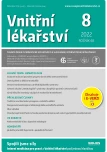Differential diagnosis of hyponatremia and hypernatremia
Authors:
Otakar Pšenička; Jarmila Křížová
Authors‘ workplace:
3. interní klinika 1. LF UK a VFN, Praha
Published in:
Vnitř Lék 2022; 68(E-8): 23-28
Category:
Differential Diagnosis Column or What You Can Be Asked at a Postgraduate Certification Exam
doi:
https://doi.org/doi.org/10.36290/vnl.2022.118
Overview
Dysnatremias are among the most common mineral imbalances encountered in clinical practice. Both hyponatremia and hypernatremia are associated with increased morbiditidy and mortality and represent negative prognostic factors regardless of their cause. Serum osmolality, extracellular fluid volume and sodium urine concentration are important parameters for evaluation the cause and differential diagnosis. The rate of onset of ionic disorder and severity of clinical symptoms are essential. While acute disorders with symptoms are treated immediately, in chronic disorders, thorough diagnostic evaluation and a careful approach to their correction are necessary. Especially with rapid substitution of chronic hyponatremia, there is a risk of osmotic demyelination syndrome. Therefore, a slow correction of the serum sodium level with frequent mineralogram checks is required.
Keywords:
hyponatremia – SIADH – hypernatremia – osmolality – osmotic demyelination syndrome
Sources
1. Spasovski G, Vanholder R, Allolio B et al. Hyponatraemia Guideline Development Group. Clinical practice guideline on diagnosis and treatment of hyponatraemia. Eur J Endocrinol. 2014 Feb 25;170(3):G1-47.
2. Upadhyay A, Jaber BL, Madias NE. Epidemiology of hyponatremia. Semin Nephrol. 2009 May;29(3):227-38.
3. Lu H, Vollenweider P, Kissling S et al. Prevalence and Description of Hyponatremia in a Swiss Tertiary Care Hospital: An Observational Retrospective Study. Front Med (Lausanne). 2020 Sep 11;7 : 512.
4. Gill G, Huda B, Boyd A et al. Characteristics and mortality of severe hyponatraemia - --a hospital‑based study. Clin Endocrinol (Oxf). 2006 Aug;65(2):246-9.
5. Katrangi W, Baumann NA, Nett RC et al. Prevalence of Clinically Significant Differences in Sodium Measurements Due to Abnormal Protein Concentrations Using an Indirect Ion‑Selective Electrode Method. J Appl Lab Med. 2019 Nov;4(3):427-432.
6. Hoorn EJ, Halperin ML, Zietse R. Diagnostic approach to a patient with hyponatraemia: traditional versus physiology‑based options. QJM. 2005 Jul;98(7):529-40.
7. Fenske W, Maier SK, Blechschmidt A et al. Utility and limitations of the traditional diagnostic approach to hyponatremia: a diagnostic study. Am J Med. 2010 Jul;123(7):652-7.
8. Sherlock M, Thompson CJ. The syndrome of inappropriate antidiuretic hormone: current and future management options. Eur J Endocrinol. 2010 Jun;162 Suppl 1:S13-8.
9. Jiskra J. Hyponatremie: Diagnostický postup a nové léčebné možnosti. Interní Med. 2012;14(8 a 9):312-317.
10. Verbalis JG, Goldsmith SR, Greenberg A e tal. Diagnosis, evaluation, and treatment of hyponatremia: Expert panel recommendations. Am J Med. 126[Suppl 1] S1–S42,2013
11. Rozen‑Zvi B, Yahav D, Gheorghiade M et al. Vasopressin receptor antagonists for the treatment of hyponatremia: Systematic review and metaanalysis. Am J Kidney Dis 56 : 325–337, 2.
12. Gankam Kengne F, Couturier BS, Soupart A et al. Urea minimizes brain complications following rapid correction of chronic hyponatremia compared with vasopressin antagonist or hypertonic saline. Kidney Int. 2015 Feb;87(2):323-31.
13. Liamis G, Filippatos TD, Elisaf MS. Evaluation and treatment of hypernatremia: a practical guide for physicians. Postgrad Med. 2016;128(3):299-306.
14. Lindner G, Funk GC. Hypernatremia in critically ill patients. J Crit Care. 2013 Apr;28(2):216. e11-20.
15. Funk GC, Lindner G, Druml W et al. Incidence and prognosis of dysnatremias present on ICU admission. Intensive Care Med. 2010 Feb;36(2):304-11.
16. Hooper L, Abdelhamid A, Attreed NJ et al. Clinical symptoms, signs and tests for identification of impending and current water‑loss dehydration in older people. Cochrane Database Syst Rev. 2015 Apr 30;2015(4):CD009647.
17. Christ‑Crain M, Winzeler B, Refardt J. Diagnosis and management of diabetes insipidus for the internist: an update. J Intern Med. 2021 Jul;290(1):73-87.
18. Hillier TA, Abbott RD, Barrett EJ. Hyponatremia: evaluating the correction factor for hyperglycemia. Am J Med. 1999 Apr;106(4):399-403.
Labels
Diabetology Endocrinology Internal medicineArticle was published in
Internal Medicine

2022 Issue E-8
Most read in this issue
- Differential diagnosis of hyponatremia and hypernatremia
- How to convince a patient refusing colonoscopy – a qualitative study
- Liddle syndrome
- Ethanol ablation of recurrent symptomatic thyroid cystic nodules in the Czech Republic
